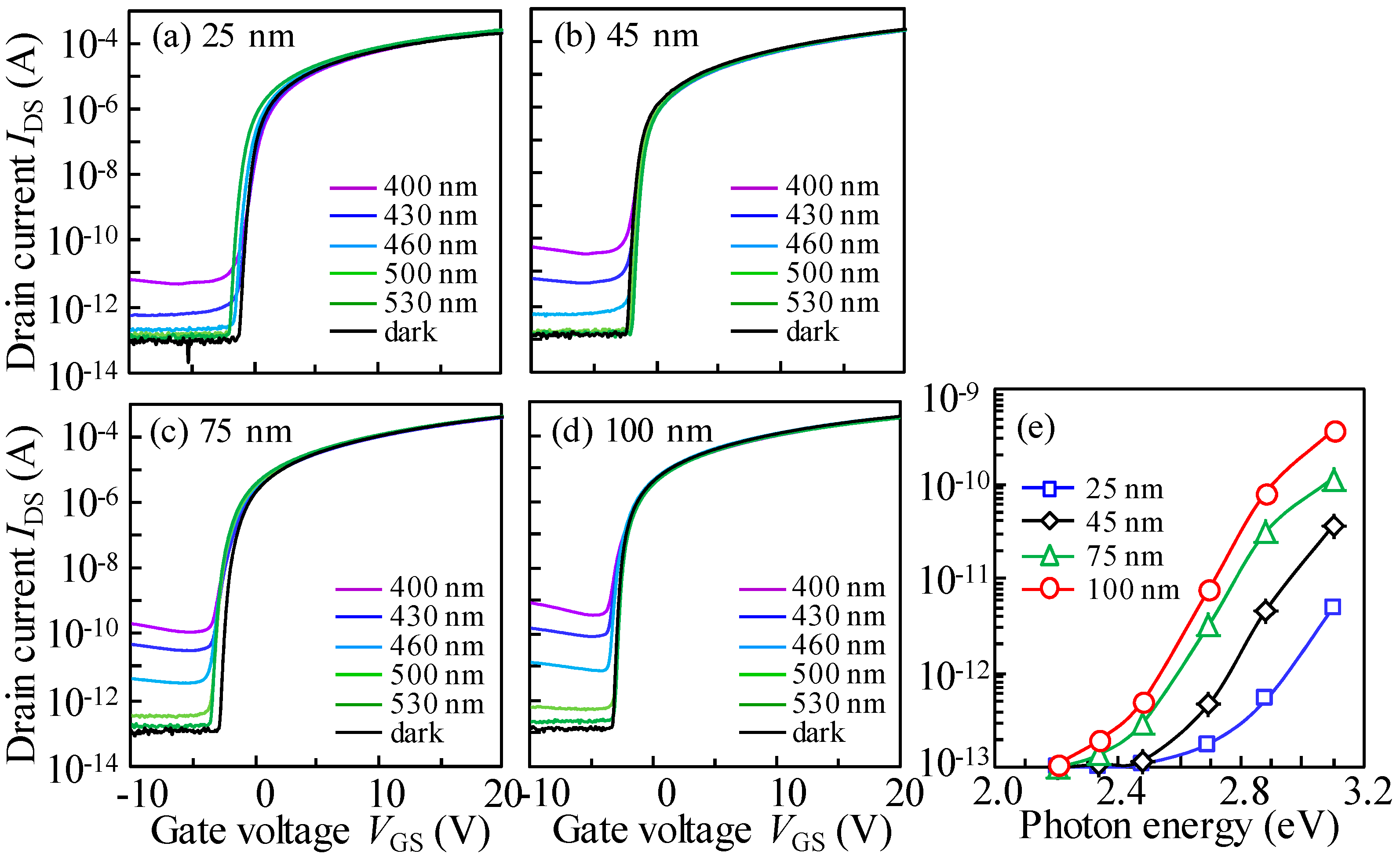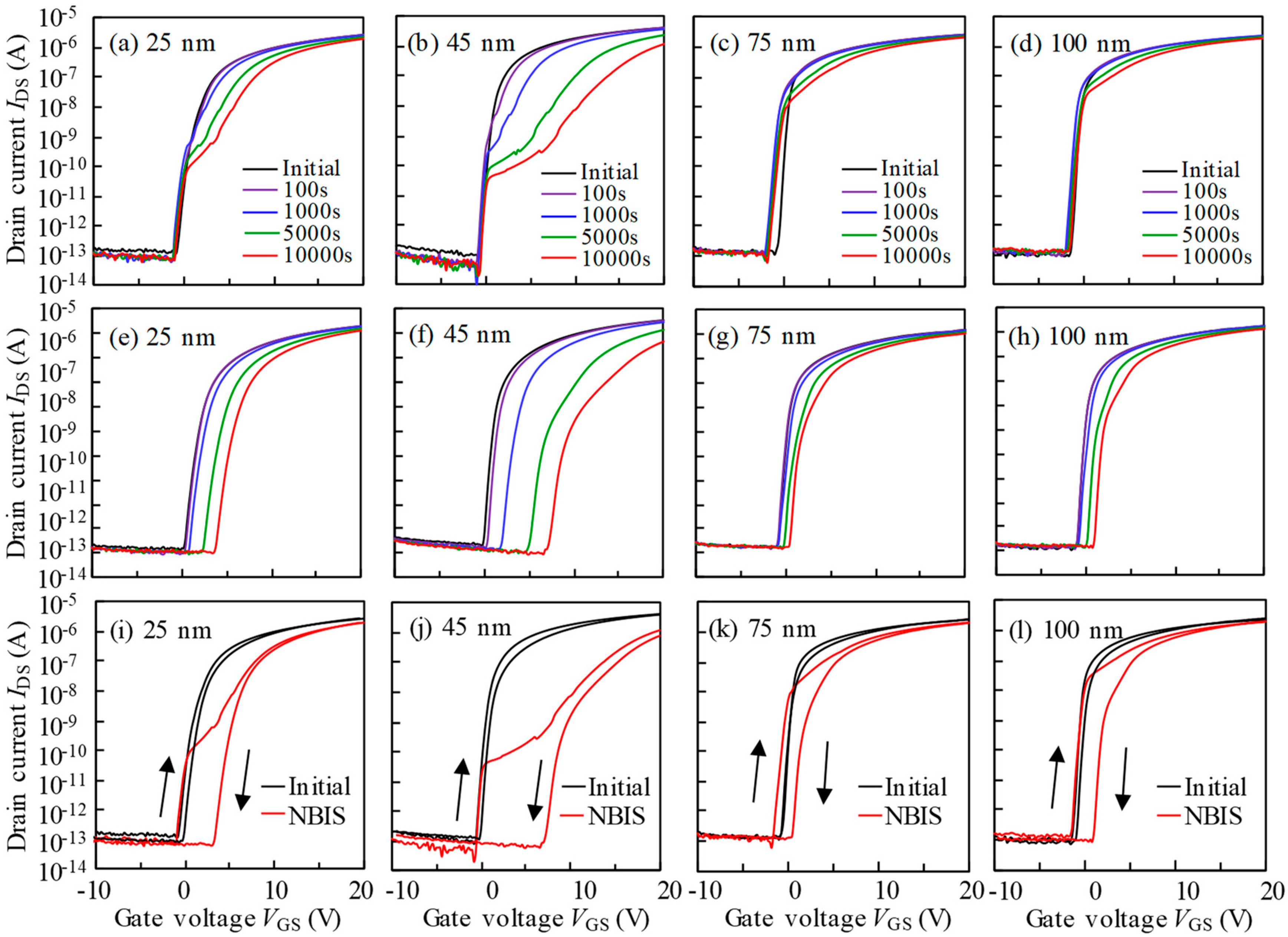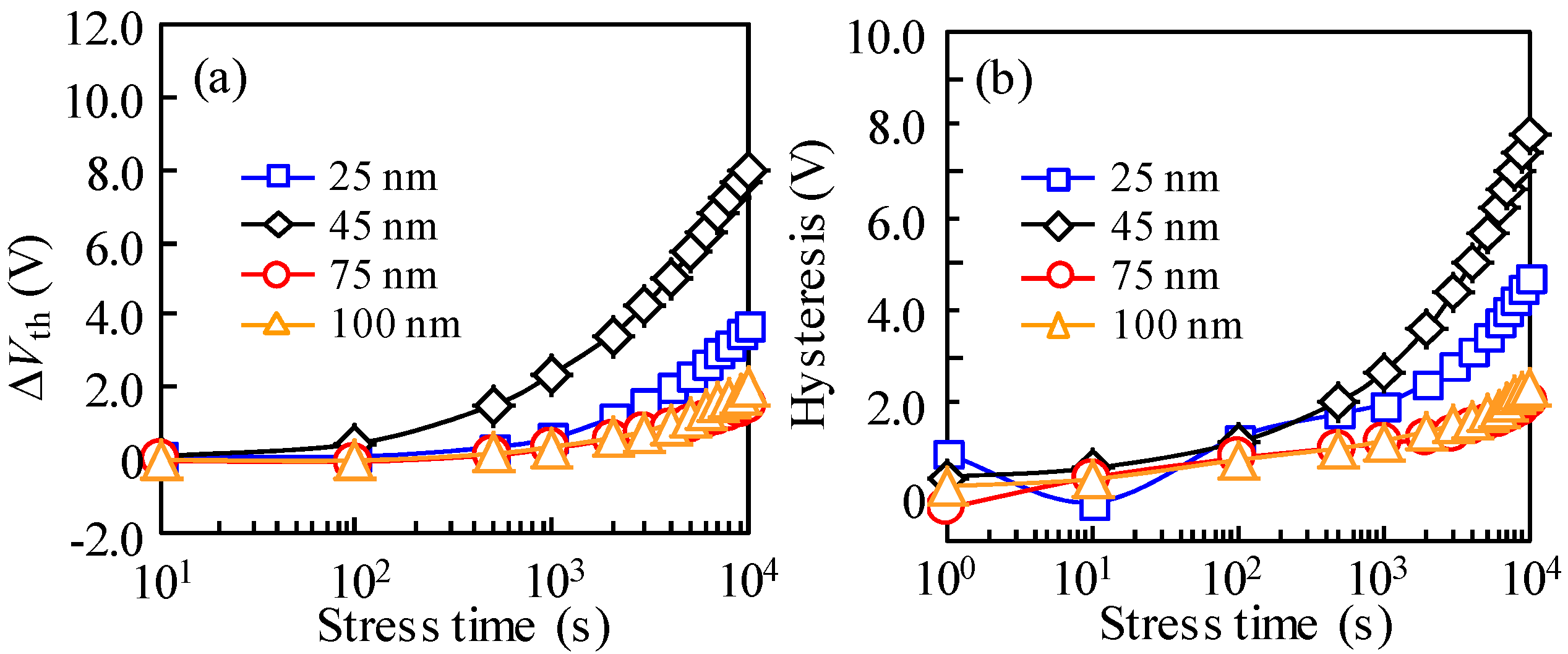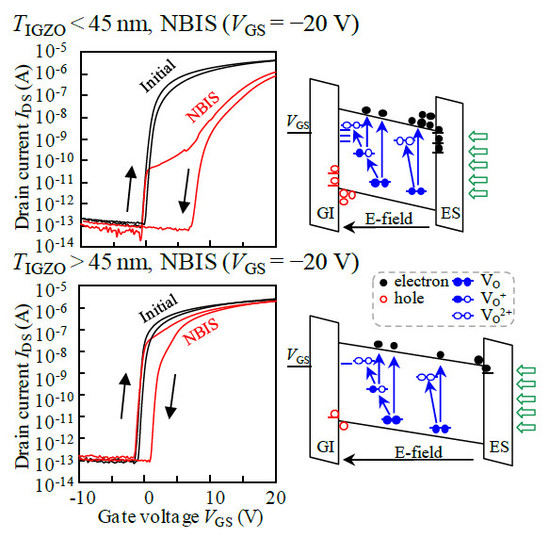Impact of Photo-Excitation on Leakage Current and Negative Bias Instability in InSnZnO Thickness-Varied Thin-Film Transistors
Abstract
:1. Introduction
2. Experimental Methods
3. Results and Discussion
4. Conclusions
Author Contributions
Funding
Acknowledgments
Conflicts of Interest
References
- Hirao, T.; Furuta, M.; Hiramatsu, T.; Matsuda, T.; Li, C.; Furuta, H.; Hokari, H.; Yoshida, M.; Ishii, H.; Kakegawa, M. Bottom-gate zinc oxide thin-film transistors (ZnO TFTs) for AM-LCDs. IEEE Trans. Electron Dev. 2008, 55, 3136–3142. [Google Scholar] [CrossRef]
- Shin, K.Y.; Tak, Y.J.; Kim, W.G.; Hong, S.; Kim, H.J. Improvement of Electrical Characteristics and Stability of Amorphous Indium Gallium Zinc Oxide Thin Film Transistors Using Nitrocellulose Passivation Layer. ACS Appl. Mater. Interfaces 2019, 9, 13278–13285. [Google Scholar] [CrossRef] [PubMed]
- Zan, H.W.; Yeh, C.C.; Meng, H.F.; Tsai, C.C.; Chen, L.H. Achieving High Field-Effect Mobility in Amorphous Indium-Gallium-Zinc Oxide by Capping a Strong Reduction Layer. Adv. Mater. 2012, 24, 3509–3514. [Google Scholar] [CrossRef] [PubMed]
- An, H.J.; Kim, H.M.; Lee, W.; Myoung, J.M. Solution-based flexible indium oxide thin-film transistors with high mobility and stability by selective surface modification. Mater. Sci. Semicond. Process. 2019, 102, 104590. [Google Scholar] [CrossRef]
- Lee, I.S.; Tak, Y.J.; Kang, B.H.; Yoo, H.; Jung, S.; Kim, H.J. Mechanochemical and Thermal Treatment for Surface Functionalization to Reduce the Activation Temperature of In-Ga-Zn-O Thin-film Transistors. ACS Appl. Mater. Interfaces 2020, 12, 19123–19129. [Google Scholar] [CrossRef] [PubMed]
- Wang, G.; Chang, B.; Yang, H.; Zhou, X.; Zhang, L.; Zhang, X.; Zhang, S. Implementation of Self-Aligned Top-Gate Amorphous Zinc Tin Oxide Thin-Film Transistors. IEEE Electr. Device Lett. 2019, 40, 901–904. [Google Scholar] [CrossRef]
- Wang, D.; Li, C.; Furuta, M. Influence of active layer thickness on performance and reliability of InSnZnO thin-film transistors. In Proceedings of the 19th International Workshop on AM-FPD, Kyoto, Japan, 4–6 July 2012; pp. 159–162. [Google Scholar]
- Nakata, M.; Zhao, C.; Kanicki, J. DC sputtered amorphous In–Sn–Zn–O thin-film transistors: Electrical properties and stability. Solid State Electron. 2016, 116, 22–29. [Google Scholar] [CrossRef]
- Shimakawa, S.; Wang, D.; Furuta, M. Photo Induced Negative Bias Instability of Zinc Oxide Thin-Film Transistors. Jpn. J. Appl. Phys. 2012, 51, 108003. [Google Scholar] [CrossRef]
- Yarali, E.; Koutsiaki, C.; Faber, H.; Tetzner, K.; Yengel, E.; Patsalas, P.; Kalfagiannis, N.; Koutsogeorgis, D.C.; Anthopoulos, T.D. Recent Progress in Photonic Processing of Metal-Oxide Transistors. Adv. Funct. Mater. 2020, 30, 1906022. [Google Scholar] [CrossRef] [Green Version]
- Kim, H.J.; Park, K.; Kim, H.J. High-performance vacuum-processed metal oxide thin-film transistors: A review of recent developments. J. Soc. Inf. Display 2020, 28, 591–622. [Google Scholar] [CrossRef]
- Jeong, H.-Y.; Nam, S.-H.; Park, K.-S.; Yoon, S.-Y.; Park, C.; Jang, J. Significant Performance and Stability Improvements of Low-Temperature IGZO TFTs by the Formation of In-F Nanoparticles on an SiO2 Buffer Layer. Nanomaterials 2020, 10, 1165. [Google Scholar] [CrossRef] [PubMed]
- Kesorn, P.; Bermundo, J.P.; Nonaka, T.; Fujii, M.N.; Ishikawa, Y.; Uraoka, Y. High Performance Amorphous In–Ga–Zn–O Thin-Film Transistors with Low Temperature High-k Solution Processed Hybrid Gate Insulator. ECS J. Solid State Sci. Technol. 2020, 9, 049001. [Google Scholar] [CrossRef]
- Wang, D.; Furuta, M.; Tomai, S.; Yano, K. Understanding the Role of Temperature and Drain Current Stress in InSnZnO TFTs with Various Active Layer Thicknesses. Nanomaterials 2020, 10, 617. [Google Scholar] [CrossRef] [PubMed] [Green Version]
- Chen, A.H.; Cao, H.T.; Zhang, H.Z.; Liang, L.Y.; Liu, Z.M.; Yu, Z.; Wan, Q. Influence of the channel layer thickness on electrical properties of indium zinc oxide thin-film transistor. Microelectron. Eng. 2010, 87, 2019–2023. [Google Scholar] [CrossRef]
- Li, Y.; Pei, Y.L.; Hu, R.Q.; Chen, Z.M.; Zhao, Y.; Shen, Z.; Fan, B.F.; Liang, J.; Wang, G. Effect of channel thickness on electrical performance of amorphous IGZO thin-film transistor with atomic layer deposited alumina oxide dielectric. Curr. Appl. Phys. 2014, 14, 941–945. [Google Scholar] [CrossRef]
- Cheng, M.H.; Zhao, C.; Huang, C.L.; Kim, H.; Nakata, M.; Kanicki, J. Amorphous InSnZnO Thin-Film Transistor Voltage-Mode Active Pixel Sensor Circuits for Indirect X-Ray Imagers. IEEE Trans. Electron Dev. 2016, 63, 4802–4810. [Google Scholar] [CrossRef]
- Choi, P.; Lee, J.; Park, H.; Baek, D.; Lee, J.; Yi, J.; Kim, S.; Choi, B. Fabrication and Characteristics of High Mobility InSnZnO Thin Film Transistors. J. Nanosci. Nanotechnol. 2016, 16, 4788–4791. [Google Scholar] [CrossRef]
- Fukumoto, E.; Arai, T.; Morosawa, N.; Tokunaga, K.; Terai, Y.; Fujimori, T.; Sasaoka, T. High-mobility oxide TFT for circuit integration of AMOLEDs. J. SID 2011, 19, 867–872. [Google Scholar] [CrossRef]
- Hwang, S.M.; Lee, S.M.; Choi, J.H.; Lim, J.H.; Joo, J. Fabrication of Solution-Processed InSnZnO/ZrO2 Thin Film Transistors. J. Nanosci. Nanotechnol. 2013, 13, 7774–7778. [Google Scholar] [CrossRef]
- Jang, K.; Raja, J.; Lee, Y.J.; Kim, D.; Yi, J. Effects of Carrier Concentration, Indium Content, and Crystallinity on the Electrical Properties of Indium-Tin-Zinc-Oxide Thin-Film Transistors. IEEE Electr. Device Lett. 2013, 34, 1151–1153. [Google Scholar] [CrossRef]
- Ryu, M.K.; Yang, S.; Park, S.H.K.; Hwang, C.S.; Jeong, J.K. High performance thin film transistor with cosputtered amorphous Zn–In–Sn–O channel: Combinatorial approach. Appl. Phys. Lett. 2009, 95, 072104. [Google Scholar] [CrossRef]
- Zhong, W.; Li, G.; Lan, L.; Li, B.; Chen, R. InSnZnO Thin-Film Transistors with Vapor-Phase Self-Assembled Monolayer as Passivation Layer. IEEE Electr. Device Lett. 2018, 39, 1680–1683. [Google Scholar] [CrossRef]
- Shimakawa, S.; Kamada, Y.; Kawaharamura, T.; Wang, D.; Li, C.; Fujita, S.; Hirao, T.; Furuta, M. Photo-Leakage Current of Thin-Film Transistors with ZnO Channels Formed at Various Oxygen Partial Pressures under Visible Light Irradiation. Jpn. J. Appl. Phys. 2012, 51, 03CB04. [Google Scholar] [CrossRef]
- Nomura, K.; Kamiya, T.; Yanagi, H.; Ikenaga, E.; Yang, K.; Kobayashi, K.; Hirano, M.; Hosono, H. Subgap states in transparent amorphous oxide semiconductor, In–Ga–Zn–O, observed by bulk sensitive x-ray photoelectron spectroscopy. Appl. Phys. Lett. 2008, 92, 202117. [Google Scholar] [CrossRef]





| Thickness (nm) | 25 | 45 | 75 | 100 |
|---|---|---|---|---|
| μsat (cm2∙V−1∙s−1) | 34.73 | 37.61 | 41.63 | 44.26 |
| Vth at IDS = 1 nA (V) | 1.95 | 1.13 | 0.42 | −0.25 |
| ON/OFF ratio (1010) | 2.38 | 2.22 | 2.87 | 3.93 |
| Hysteresis ΔVH (V) | 0.17 | 0.16 | 0.08 | 0.04 |
| Subthreshold swing (mV/dec.) | 206 | 167 | 131 | 92 |
| Preparation of ITZO | TITZO (nm) | μsat (cm2∙V−1∙s−1) | VON (V) | IOFF (A) | ON/OFF Ratio | SS (mV/dec.) | Reference |
|---|---|---|---|---|---|---|---|
| DC sputtering | 30 | 31.19 | −0.93 | 10−14 | − | 153 | [17] |
| RF sputtering | 50 | 28.97 | − | 10−13 | 2.64 × 107 | ~200 | [18] |
| DC sputtering | − | 30.90 | 0.97 | 10−14 | − | ~210 | [19] |
| Spin-coating | 41 | 9.80 | −1.50 | 10−7 | 1.30 × 103 | ~2300 | [20] |
| − | 50 | 37.20 | − | 10−12 | ~1 × 107 | ~930 | [21] |
| Co-sputtering | 25 | 24.60 | −0.40 | 10−14 | 109 | ~120 | [22] |
| Co-sputtering | 60 | 10.40 | 2.10 | 10−12 | 2.30 × 107 | 93 | [23] |
| RF sputtering | 100 | 44.26 | −0.25 | 10−14 | >1010 | 92 | This work |
© 2020 by the authors. Licensee MDPI, Basel, Switzerland. This article is an open access article distributed under the terms and conditions of the Creative Commons Attribution (CC BY) license (http://creativecommons.org/licenses/by/4.0/).
Share and Cite
Wang, D.; Furuta, M.; Tomai, S.; Yano, K. Impact of Photo-Excitation on Leakage Current and Negative Bias Instability in InSnZnO Thickness-Varied Thin-Film Transistors. Nanomaterials 2020, 10, 1782. https://doi.org/10.3390/nano10091782
Wang D, Furuta M, Tomai S, Yano K. Impact of Photo-Excitation on Leakage Current and Negative Bias Instability in InSnZnO Thickness-Varied Thin-Film Transistors. Nanomaterials. 2020; 10(9):1782. https://doi.org/10.3390/nano10091782
Chicago/Turabian StyleWang, Dapeng, Mamoru Furuta, Shigekazu Tomai, and Koki Yano. 2020. "Impact of Photo-Excitation on Leakage Current and Negative Bias Instability in InSnZnO Thickness-Varied Thin-Film Transistors" Nanomaterials 10, no. 9: 1782. https://doi.org/10.3390/nano10091782
APA StyleWang, D., Furuta, M., Tomai, S., & Yano, K. (2020). Impact of Photo-Excitation on Leakage Current and Negative Bias Instability in InSnZnO Thickness-Varied Thin-Film Transistors. Nanomaterials, 10(9), 1782. https://doi.org/10.3390/nano10091782







